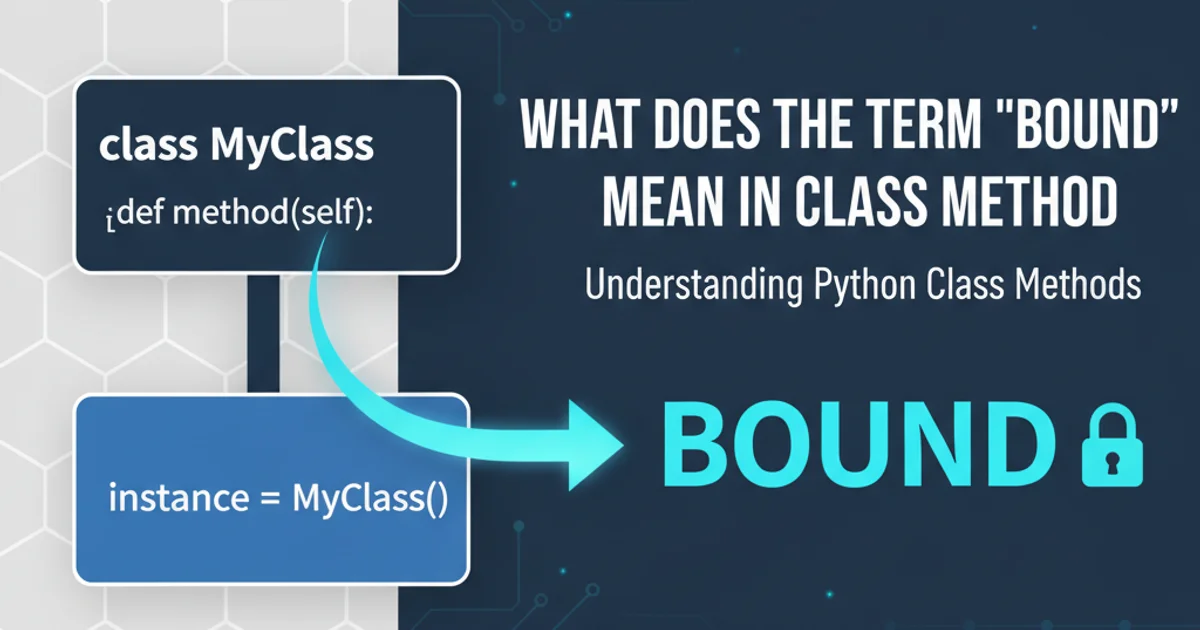what does the term 'bound' means in class method
Categories:
Understanding 'Bound' Methods in Python Classes

Explore the concept of 'bound' methods in Python, how they differ from unbound methods, and their implications for object-oriented programming in Python 2.x and 3.x.
In Python, the term 'bound' method refers to a function that is associated with an instance of a class. When you access a method through an object instance, Python automatically 'binds' the instance to the method, passing it as the first argument (conventionally named self). This mechanism is fundamental to how object-oriented programming works in Python, allowing methods to operate on the specific data of the instance they are called upon.
The Essence of Bound Methods
A bound method is essentially a wrapper around a function that ensures the instance it belongs to is automatically passed as the first argument. This happens implicitly when you call instance.method(). Without this binding, a method would just be a regular function, unable to access the instance's attributes. The binding process transforms a class's function into an instance's method.
flowchart TD
A[Class Definition] --> B{Method Lookup on Instance}
B --> C{Is it a function?}
C -->|Yes| D[Create Bound Method]
D --> E[Call Bound Method (self implicitly passed)]
C -->|No| F[It's already a bound method or other attribute]
E --> G[Method Executes on Instance Data]Flowchart illustrating the process of method binding in Python.
Bound vs. Unbound Methods (Python 2.x vs. 3.x)
The distinction between bound and unbound methods was more explicit and significant in Python 2.x than in Python 3.x. In Python 2.x, a method accessed directly from the class (e.g., MyClass.my_method) was considered an 'unbound method' and required the instance to be explicitly passed as the first argument. When accessed via an instance (e.g., my_instance.my_method), it became a 'bound method'.
Python 3.x simplified this. All functions defined within a class are now just regular functions. The 'binding' behavior still occurs when accessed via an instance, but the concept of an 'unbound method' object type has been removed. Accessing MyClass.my_method in Python 3.x directly returns the function object itself, not a special 'unbound method' object.
class MyClass:
def greet(self):
return f"Hello from {self.__class__.__name__}!"
# Python 3.x behavior
instance = MyClass()
# Bound method: 'self' is automatically passed
bound_method = instance.greet
print(f"Type of bound_method: {type(bound_method)}")
print(f"Calling bound_method: {bound_method()}")
# Accessing method via class: returns the function object
unbound_function = MyClass.greet
print(f"Type of unbound_function: {type(unbound_function)}")
# To call it, you must explicitly pass an instance
print(f"Calling unbound_function with instance: {unbound_function(instance)}")
Demonstrating bound methods and class-level function access in Python 3.x.
self implicitly when a method is called on an instance remains the same. Understanding this is crucial for writing correct object-oriented code.Practical Implications and Use Cases
The concept of bound methods is fundamental to polymorphism and encapsulation in Python. It allows different instances of the same class to maintain their own state while sharing the same method implementations. When you pass a bound method as a callback, it carries its self reference with it, ensuring it operates on the correct instance.
For example, in GUI programming or event handling, you often pass a method of an object as a callback function. Because it's a bound method, when the event triggers, the method is called with the correct instance context, allowing it to modify that specific object's state or interact with its attributes.
class Button:
def __init__(self, label):
self.label = label
self.click_count = 0
def on_click(self):
self.click_count += 1
print(f"Button '{self.label}' clicked! Total clicks: {self.click_count}")
# Simulate a GUI framework where you register a callback
def register_callback(callback_func):
print(f"Registering callback: {callback_func.__name__}")
# In a real GUI, this would be triggered by a user action
callback_func() # Simulate a click
button1 = Button("Submit")
button2 = Button("Cancel")
print("--- Registering Button 1's click handler ---")
register_callback(button1.on_click) # button1.on_click is a bound method
register_callback(button1.on_click)
print("\n--- Registering Button 2's click handler ---")
register_callback(button2.on_click) # button2.on_click is a different bound method
print(f"\nFinal click counts: Button 1: {button1.click_count}, Button 2: {button2.click_count}")
Example of bound methods used as callbacks, maintaining instance state.